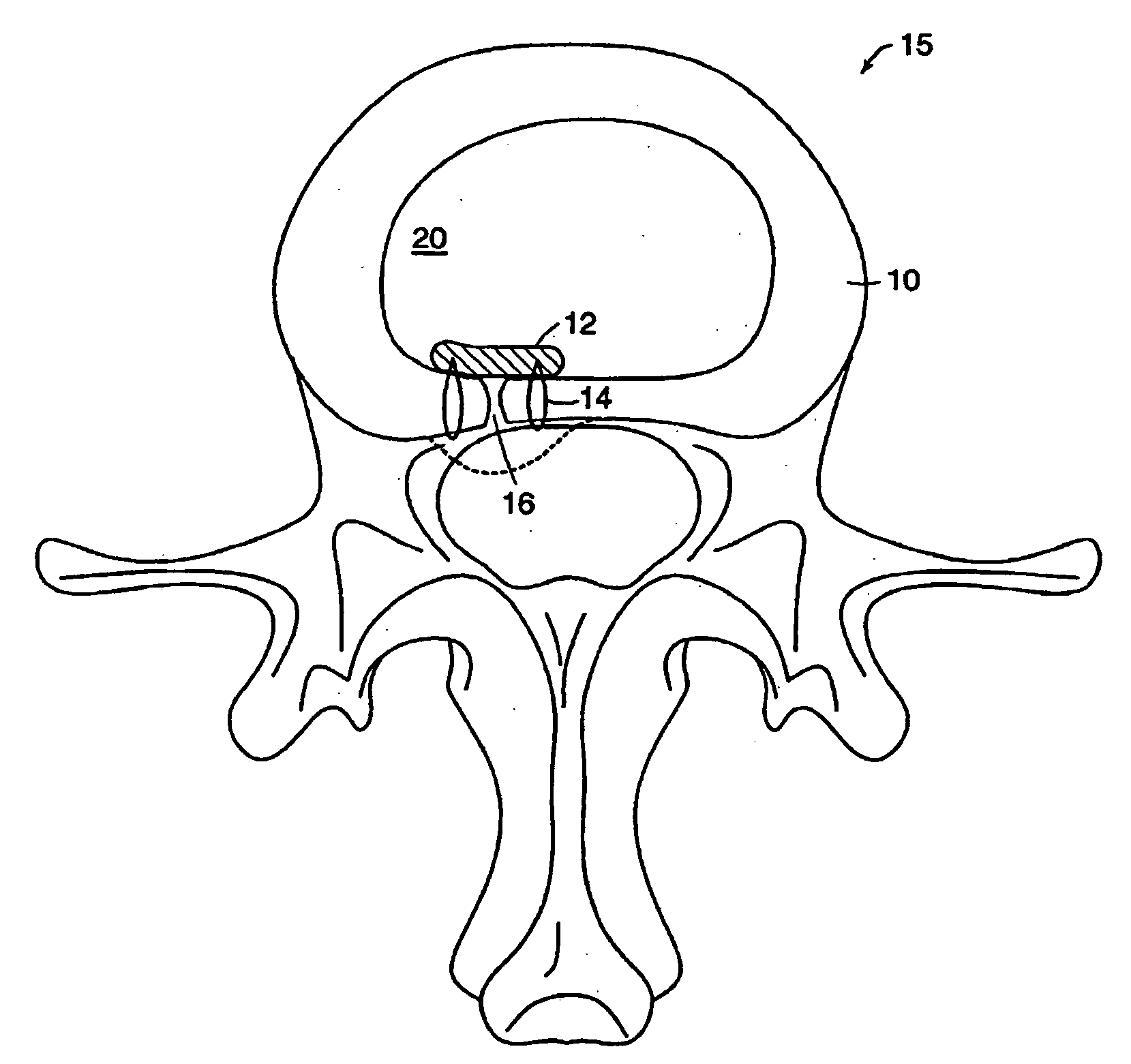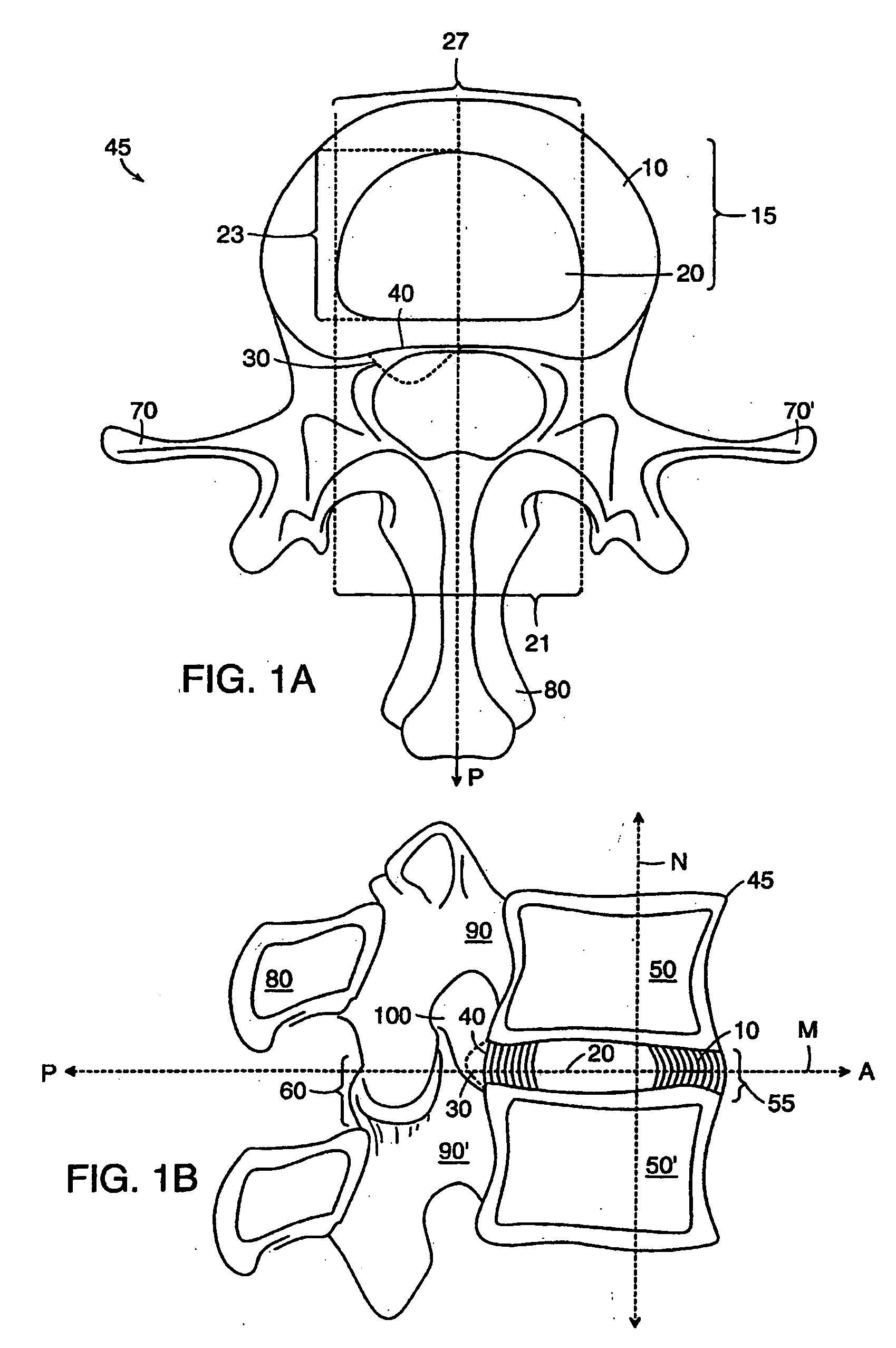The most common resulting symptoms are pain radiating along a compressed nerve and
low back pain, both of which can be crippling for the patient.
Nevertheless, the most significant drawbacks of
discectomy are recurrence of herniation, recurrence of radicular symptoms, and increasing
low back pain.
All of these failings are most directly related to the loss of NP material and AF competence that results from herniation and
surgery.
Loss of NP material deflates the disc, causing a decrease in
disc height.
This leads to foraminal
stenosis, pinching of the traversing
nerve root, and recurring radicular pain.
Loss of NP also increases loading on the remaining AF, a partially innervated structure that can produce pain.
Finally, loss of NP results in greater bulging of the AF under load.
This can result in renewed impingement by the AF on nerve structures posterior to the disc.
This may over-stress the facets and contribute to their deterioration.
In these cases, not only is re-hemiation a risk but also leakage of fluids or solids from within the NP into the
epidural space can occur.
Partial and total meniscectomy leads to increased osteoarthritic degeneration in the knee and the need for further
surgery in many patients.
The drawback of this method is that it is limited to the repair of a tear in
soft tissue.
In the
intervertebral disc, closure of a tear in the AF does not necessarily prevent further bulging of that disc segment toward the posterior neural elements.
However, all of the limitations pertaining to repair of intervertebral discs, as described above, pertain to this device.
The known embodiments and methods are limited in their application to hernias of the
intervertebral disc in that they require a spring to apply tension.
Aside from the difficulty of placing a spring within the limited space of the intervertebral disc, a spring will induce a continuous displacement of the attached tissues that could be deleterious to the
structure and function of the disc.
This has the drawback of requiring a second procedure.
This augmentation is limited in many ways.
First, by replacing the entire disc, they generally must endure all of the loads that are transferred through that
disc space.
Many degenerated discs are subject to
pathologic loads that exceed those in normal discs.
None of these augmentation devices has yet been able to achieve both qualities.
Further, devices that replace the entire disc must be implanted using relatively invasive procedures, normally from an
anterior approach.
The limitation of these concepts is that the AF is often not intact in cases requiring augmentation of the disc.
There are either rents in the AF or structural weaknesses that allow herniation or migration of the disclosed implants.
In the case of a
disc herniation, there are definite weaknesses in the AF that allowed the herniation to occur.
Augmenting the NP with any of the known augmentation devices without supporting the AF or
implant risks re-hemiation of the augmenting materials.
Further, those devices with deployable elements risk injuring the vertebral endplates or the AF.
Additionally, as the disc continues to degenerate, rents in the posterior anulus may occur in regions other than the original operated site.
A further limitation of these concepts is that they require the removal of much or all of the NP to allow
insertion of the
implant.
This requires time and skill to achieve and permanently alters the
physiology of the disc.
Implanting prostheses in specific locations within the intervertebral disc is also a challenging task.
The rigorous requirements presented by these limitations on access to and
visualization of the disc are not well compensated for by any of the intradiscal
prosthesis implantation systems currently available.
The known planar patches are limited in their application in the intervertebral disc by the disc's geometry.
In the disc, it is difficult to create such a cavity between the inner wall of the anulus and the NP without removing
nucleus material.
Such removal may be detrimental to the clinical outcome of
disc repair.
However, placing a plug into the AF that must
resist much higher pressures may result in expulsion of the plug or
dissection of the inner
layers of the anulus by the NP.
Either complication would lead to extraordinary pain or loss of function for the patient.
Further, a
hernia in the intervertebral disc is likely to spread as the AF progressively weakens.
This device may be well suited for inguinal hernias, but the shape and stiffness of the disclosed embodiments are less than optimal for application in hernias of the intervertebral disc.
A
disadvantage of this device is that the
balloon must remain inflated for the remainder of the patient's life to insure closure of the defect.
Implanted, inflated devices rarely endure long periods without leaks, particularly when subjected to high loads.
This method has the drawback of relying entirely on the integrity of the wall surrounding the defect to hold the patch in place.
The anulus is often weak in areas around a defect and may not serve as a suitable anchoring site.
Further, the planar nature of the patch has all of the weaknesses discussed above.
Additionally, such devices and methods embodied for use in the vascular
system require a space relatively empty of solids for the deployment of the interior anchor.
 Login to View More
Login to View More 


